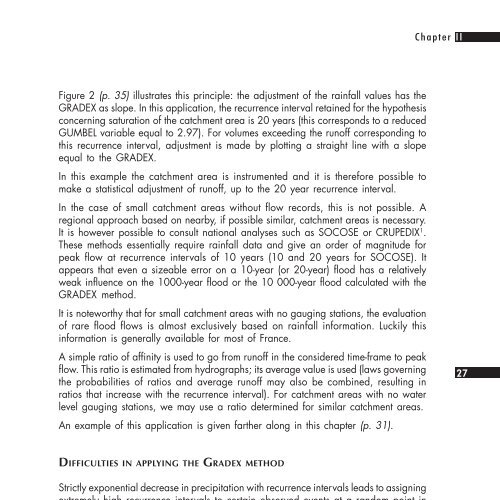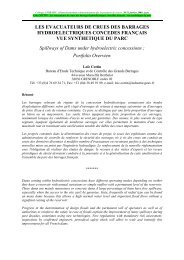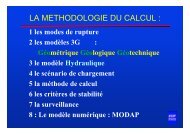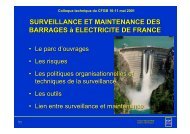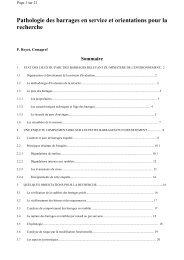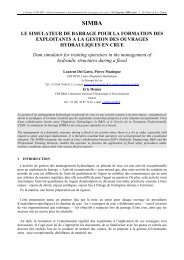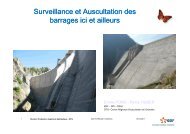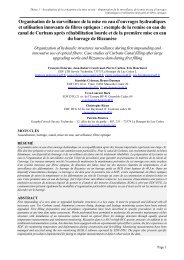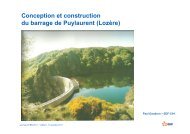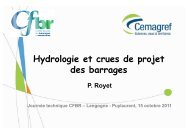SMALL DAMS
SMALL DAMS - Comité Français des Barrages et Réservoirs
SMALL DAMS - Comité Français des Barrages et Réservoirs
- No tags were found...
Create successful ePaper yourself
Turn your PDF publications into a flip-book with our unique Google optimized e-Paper software.
Chapter II<br />
Figure 2 (p. 35) illustrates this principle: the adjustment of the rainfall values has the<br />
GRADEX as slope. In this application, the recurrence interval retained for the hypothesis<br />
concerning saturation of the catchment area is 20 years (this corresponds to a reduced<br />
GUMBEL variable equal to 2.97). For volumes exceeding the runoff corresponding to<br />
this recurrence interval, adjustment is made by plotting a straight line with a slope<br />
equal to the GRADEX.<br />
In this example the catchment area is instrumented and it is therefore possible to<br />
make a statistical adjustment of runoff, up to the 20 year recurrence interval.<br />
In the case of small catchment areas without flow records, this is not possible. A<br />
regional approach based on nearby, if possible similar, catchment areas is necessary.<br />
It is however possible to consult national analyses such as SOCOSE or CRUPEDIX 1 .<br />
These methods essentially require rainfall data and give an order of magnitude for<br />
peak flow at recurrence intervals of 10 years (10 and 20 years for SOCOSE). It<br />
appears that even a sizeable error on a 10-year (or 20-year) flood has a relatively<br />
weak influence on the 1000-year flood or the 10 000-year flood calculated with the<br />
GRADEX method.<br />
It is noteworthy that for small catchment areas with no gauging stations, the evaluation<br />
of rare flood flows is almost exclusively based on rainfall information. Luckily this<br />
information is generally available for most of France.<br />
A simple ratio of affinity is used to go from runoff in the considered time-frame to peak<br />
flow. This ratio is estimated from hydrographs; its average value is used (laws governing<br />
the probabilities of ratios and average runoff may also be combined, resulting in<br />
ratios that increase with the recurrence interval). For catchment areas with no water<br />
level gauging stations, we may use a ratio determined for similar catchment areas.<br />
An example of this application is given farther along in this chapter (p. 31).<br />
27<br />
DIFFICULTIES IN APPLYING THE GRADEX METHOD<br />
Strictly exponential decrease in precipitation with recurrence intervals leads to assigning<br />
extremely high recurrence intervals to certain observed events at a random point in<br />
France. It is true that total rainfall over 500 mm in 24 hours is not really exceptional in<br />
certain areas of France, but it is limited to certain regions: around 1000 mm in the<br />
Canigou region of the eastern Pyrenees, in October 1940; 800 mm in the Solenzara<br />
region of Corsica, in October 1993, etc. The standard design flood used in<br />
dimensioning a dam is therefore not the maximum flood that could occur.<br />
There is no well-defined rule to calculate the time during which the hypothesis of<br />
equal increase in rainfall and in runoff is applied. Only a detailed coupled analysis<br />
of rainfall and floods will result in an estimate that is not too risky. In the absence of<br />
1. See Bibliography, reference 1, p. 36. The SOCOSE method is derived from the work of the<br />
American Soil Conservation Service.


